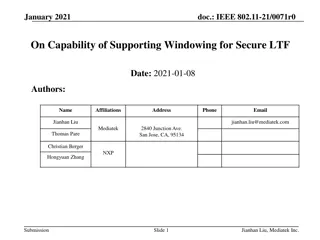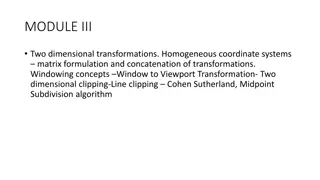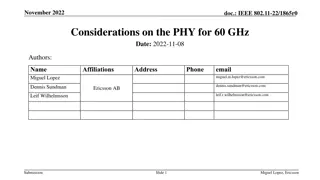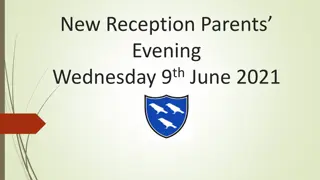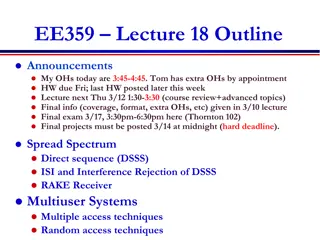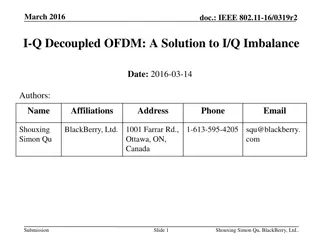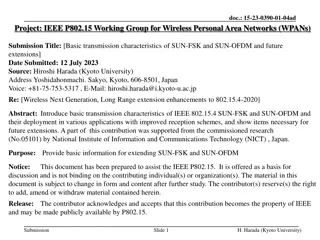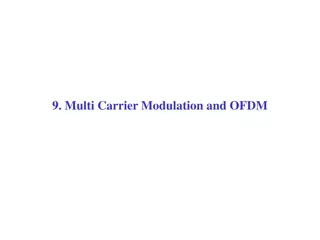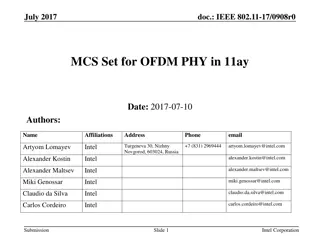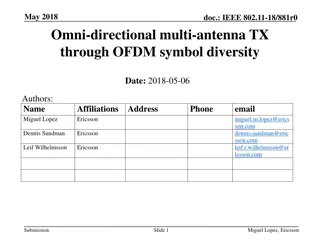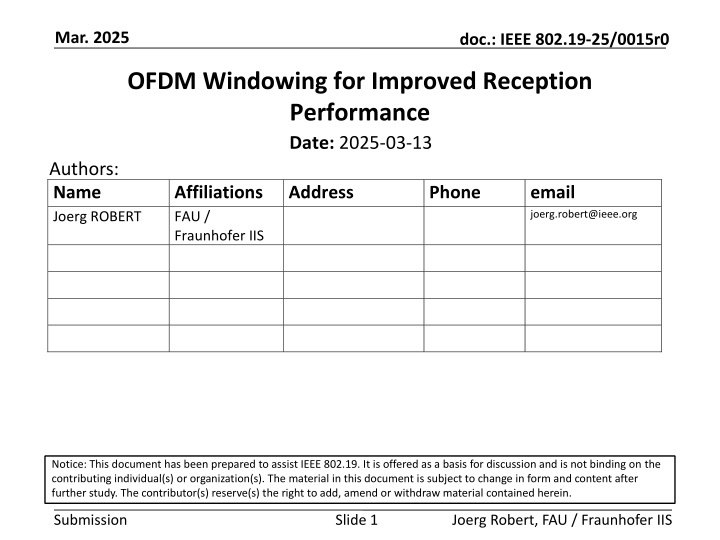
OFDM Windowing for Enhanced Reception Performance
Explore the utilization of windowing techniques in OFDM systems to mitigate narrow-band interference, enhancing reception performance without altering standards. Learn about the challenges, solutions, and potential benefits for sub-GHz bands.
Download Presentation

Please find below an Image/Link to download the presentation.
The content on the website is provided AS IS for your information and personal use only. It may not be sold, licensed, or shared on other websites without obtaining consent from the author. If you encounter any issues during the download, it is possible that the publisher has removed the file from their server.
You are allowed to download the files provided on this website for personal or commercial use, subject to the condition that they are used lawfully. All files are the property of their respective owners.
The content on the website is provided AS IS for your information and personal use only. It may not be sold, licensed, or shared on other websites without obtaining consent from the author.
E N D
Presentation Transcript
Mar. 2025 doc.: IEEE 802.19-25/0015r0 OFDM Windowing for Improved Reception Performance Date: 2025-03-13 Authors: Name Joerg ROBERT Affiliations FAU / Fraunhofer IIS Address Phone email joerg.robert@ieee.org Notice: This document has been prepared to assist IEEE 802.19. It is offered as a basis for discussion and is not binding on the contributing individual(s) or organization(s). The material in this document is subject to change in form and content after further study. The contributor(s) reserve(s) the right to add, amend or withdraw material contained herein. Submission Slide 1 Joerg Robert, FAU / Fraunhofer IIS
Mar. 2025 doc.: IEEE 802.19-25/0015r0 Motivation The sub-GHz bands are getting more and more crowded Some systems do not use LBT, resulting in unavoidable interference The effect of narrow-band interference on OFDM systems can be reduced significantly using optimized receivers without any need to change the standard Submission Slide 2 Joerg Robert, FAU / Fraunhofer IIS
Mar. 2025 doc.: IEEE 802.19-25/0015r0 Classical OFDM Reception Classical reception and synchronization of OFDM is e.g. described in [2] Cylic Prefix Useful Part Time FFT Submission Slide 3 Joerg Robert, FAU / Fraunhofer IIS
Mar. 2025 doc.: IEEE 802.19-25/0015r0 What is the Problem ( I / III )? Cutting out the useful part out of the time signal is a windowing function The classical window is a rectangular window In the frequency domain after the FFT we get As the payload data is also a fu function the window-sinc function has no effect Submission Slide 4 Joerg Robert, FAU / Fraunhofer IIS
Mar. 2025 doc.: IEEE 802.19-25/0015r0 What is the Problem ( II / III )? We now have a narrow-band interfering signal After the FFT we get the following spectrum Depending on the frequency f0 of the narrow-band interferer we get a sinc-function added on the payload data Submission Slide 5 Joerg Robert, FAU / Fraunhofer IIS
Mar. 2025 doc.: IEEE 802.19-25/0015r0 What is the Problem ( III / III )? Example for 802.15.4g OFDM with N=128 and 106 active carriers The narrow-band interferer spreads out Slide 6 Submission Joerg Robert, FAU / Fraunhofer IIS
Mar. 2025 doc.: IEEE 802.19-25/0015r0 Windowed OFDM Reception ( I / III ) OFDM symbol is cut out with Nyquist roll-off [1] The data is stuffed with zeros to match 2 times the FFT Only the first half of the carriers are used Cylic Prefix Useful Part Time 2xFFT Submission Slide 7 Joerg Robert, FAU / Fraunhofer IIS
Mar. 2025 doc.: IEEE 802.19-25/0015r0 Windowed OFDM Reception ( II / III ) Effect of narrow-band interferer with (red) and without windowing (blue) Interferer remains more localized Slide 8 Submission Joerg Robert, FAU / Fraunhofer IIS
Mar. 2025 doc.: IEEE 802.19-25/0015r0 Windowed OFDM Reception ( III / III ) The interfered OFDM sub-carriers still have to be detected and the data recovered by means of the forward error correction A longer the Nyquist roll-off leads to a better localization of the interferer BUT This also consumes the useable cyclic prefix Optimization required, e.g. as proposed in [3] for mobile reception The use of the Nyquist roll-off does not have to be specified in the standard, but a sufficient cyclic prefix length is required Slide 9 Submission Joerg Robert, FAU / Fraunhofer IIS
Mar. 2025 doc.: IEEE 802.19-25/0015r0 References [1] C. Muschallik, "Improving an OFDM reception using an adaptive Nyquist windowing," in IEEE Transactions on Consumer Electronics, vol. 42, no. 3, pp. 259-269, Aug. 1996 [2] M. Speth, S. Fechtel, G. Fock and H. Meyr, "Optimum receiver design for OFDM-based broadband transmission .II. A case study," in IEEE Transactions on Communications, vol. 49, no. 4, pp. 571-578, April 2001 [3] J. Robert, J. Zoellner and M. Slimani, "Adaptive Windowing for OFDM with Dense Subcarrier Spacing in Mobile Channels," OFDM 2012; 17th International OFDM Workshop 2012 (InOWo'12), Essen, Germany, 2012 Submission Slide 10 Joerg Robert, FAU / Fraunhofer IIS



